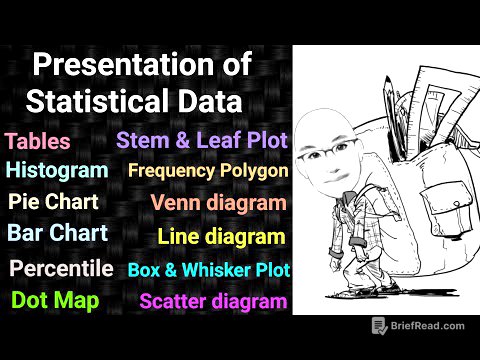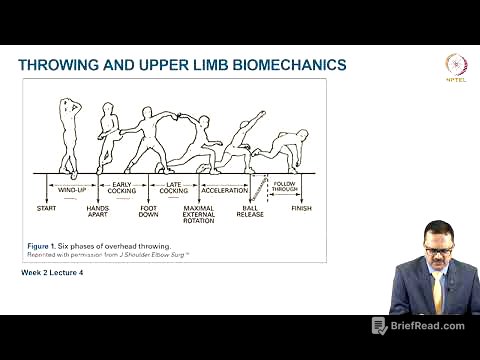TLDR;
This YouTube video by Nanak Education point provides a comprehensive one-shot explanation of Financial Accounting, tailored for students of IGNOU, SOL, and other universities. The video covers key concepts, objectives, advantages, limitations, and branches of accounting. It also explains accounting principles, accounting standards, and the differences between single and double-entry systems, cash and accrual basis accounting. Additionally, it discusses the accounting process, including journal entries, ledger postings, trial balance preparation, and subsidiary books. The video concludes with an overview of consignment and joint venture accounts.
- Covers key concepts, objectives, advantages, limitations, and branches of accounting.
- Explains accounting principles, accounting standards.
- Discusses the accounting process, including journal entries, ledger postings, trial balance preparation, and subsidiary books.
- Provides an overview of consignment and joint venture accounts.
Unit 1: Nature and Scope of Accounting [0:30]
The chapter begins by defining accountancy as the systematic knowledge of accounting, akin to learning accounting from a textbook. Accounting itself involves identifying, measuring, recording, classifying, summarizing, and communicating financial information. The accounting year is a 12-month period that concludes with the determination of profit or loss, providing insights into a company's financial standing. The objectives of accounting include maintaining systematic records to avoid forgetting transactions, determining the profit or loss of the business by tracking purchases and sales, assessing the financial position through the balance sheet (assets vs. liabilities), and providing accounting information to interested parties, both internal (owners) and external (creditors, tax authorities).
Unit 1: Scope, Advantages, and Limitations of Accounting [5:44]
The scope of accounting involves identifying, measuring, classifying, summarizing, and analyzing financial data. Internal users of accounting information are those within the company, while external users include creditors and tax authorities. Advantages of accounting include replacing memory by keeping records of transactions, providing control over assets, and facilitating the preparation of financial statements. The benefits of accounting are providing financial information about the business, replacing memory through detailed records, serving as evidence in court, facilitating comparative studies between different periods, and assisting management in planning, decision-making, and control.
Unit 1: Limitations and Branches of Accounting [10:31]
Limitations of accounting include that it is not fully exact due to estimations and potential errors, it may present unrealistic information as assets are recorded at historical cost, and it ignores qualitative elements such as skills and knowledge. The branches of accounting are financial accounting, cost accounting (determining product costs), and management accounting (managing profits, costs, and funds). Bookkeeping, performed by junior staff, involves identifying, measuring, recording, and classifying transactions, while accounting, handled by senior staff, includes summarizing, interpreting, and communicating financial data.
Unit 1: Accounting Systems - Double Entry vs. Single Entry [16:50]
Accounting systems include double entry and single entry. Double entry involves both debit and credit entries, providing a complete record of transactions, while single entry only records one aspect (either inflow or outflow of money), leading to incomplete results. Double entry is more accurate and beneficial for large businesses, providing a clear picture of profit and loss and financial position. Single entry is typically used by small shopkeepers.
Unit 1: Cash Basis vs. Accrual Basis Accounting [19:13]
Cash basis accounting records only cash transactions, while accrual basis accounting records both cash and credit transactions. Accrual basis accounting provides a more accurate picture of profit and loss as it considers all transactions, and it is recognized by the Companies Act 2013, unlike cash basis accounting.
Unit 2: Accounting Process and Rules - Understanding Accounts [22:06]
An account is a T-shaped ledger with the account name at the top, debit side on the left, and credit side on the right. The debit side is always on the left, and the credit side is always on the right. Accounts are classified using traditional and modern approaches. The traditional approach involves personal, real, and nominal accounts.
Unit 2: Traditional Approach - Personal, Real, and Nominal Accounts [23:50]
Personal accounts relate to individuals, firms, or companies (e.g., Ram Ltd.) and follow the rule "debit the receiver, credit the giver." Real accounts include assets (e.g., cash, furniture, machinery) and follow the rule "debit what comes in, credit what goes out." Nominal accounts include expenses, losses, incomes, and gains; expenses and losses are debited, while incomes and gains are credited.
Unit 2: Examples of Traditional Accounting and Introduction to Modern Classification [30:10]
Examples of applying the traditional approach include rent received (credit, nominal), machinery (debit, real), purchases (debit, nominal), and capital (credit, personal). The modern classification of accounts uses the acronym CLEAR: Capital, Liabilities, Expenses, Assets, and Revenue.
Unit 2: Modern Classification - CLEAR Approach [32:16]
In the CLEAR approach, expenses and assets increase with a debit and decrease with a credit. Capital, liabilities, and revenue increase with a credit and decrease with a debit. Examples include starting a business with cash (debit cash, credit capital) and depositing cash in a bank (debit bank, credit cash).
Unit 3: Accounting Principles - Fundamental Assumptions [38:35]
Accounting principles are flexible, man-made, and generally accepted. Fundamental assumptions include the going concern assumption (business will continue indefinitely), the consistency assumption (using the same accounting methods each year), and the accrual assumption (recording transactions when they occur, regardless of when cash is exchanged).
Unit 3: Accounting Principles - Entity, Measurement, and Period [41:58]
The accounting entity principle states that entries should be recorded from the business's point of view. The money measurement principle records transactions that can be measured in monetary terms. The accounting period principle divides the business's life into smaller periods (e.g., 12 months).
Unit 3: Accounting Principles - Full Disclosure, Materiality, and Prudence [42:51]
The full disclosure principle requires disclosing all relevant information. The materiality principle requires disclosing items that influence users' decisions. The prudence (conservatism) principle anticipates potential losses and expenses but does not account for anticipated income or profits.
Unit 3: Accounting Principles - Cost, Matching, and Dual Aspect [44:23]
The cost (historical cost) principle records transactions at the price paid. The matching principle matches expenses with revenues. The dual aspect principle states that every transaction has two aspects: a debit and a credit (Assets = Owner's Equity + Liabilities).
Unit 3: Accounting Principles - Revenue Recognition and Verifiable Objective [45:23]
The revenue recognition concept recognizes revenue when the right to receive it is established. The verifiable objective concept records transactions based on evidence (e.g., cash memos).
Unit 3: Accounting Standards - Meaning and Nature [45:56]
Accounting standards are guidelines that provide a framework for preparing credible financial statements and are mandatory in nature.
Unit 3: Key Accounting Standards [47:13]
Key accounting standards include AS-1 (presentation of financial statements), AS-2 (inventories), and AS-3 (cash flow statements).
Accounting Process: Journal, Ledger, and Trial Balance [50:22]
The accounting process involves creating a journal, then a ledger, and finally a trial balance. The journal is a primary book where transactions are first recorded in chronological order based on source documents. The ledger is a principal book where journal entries are transferred.
Accounting Process: Journal Entries [53:11]
Examples of journal entries include cash deposited in a bank (debit bank, credit cash) and cash withdrawal from the bank (debit cash, credit bank).
Accounting Process: Ledger Posting [56:10]
Ledger posting involves transferring journal entries to individual ledger accounts. The debit side of the journal entry is posted to the debit side of the ledger, and the credit side to the credit side, using "To" for debit entries and "By" for credit entries.
Accounting Process: Trial Balance [1:02:25]
The trial balance is prepared using the CLEAR acronym (Capital, Liabilities, Expenses, Assets, Revenue). Assets, drawings, expenses, and losses have debit balances, while liabilities, capital, income, and gains have credit balances.
Subsidiary Books: Cash Book, Purchase Book, and Sales Book [1:06:07]
Subsidiary books are subdivisions of the journal, including the cash book (receipts and payments), purchase book (credit purchases), sales book (credit sales), purchase return book, sales return book, and general proper (for transactions not recorded elsewhere).
Depreciation: Meaning, Causes, and Features [1:11:50]
Depreciation is the reduction in the value of a fixed asset due to wear and tear, time, obsolescence, or accidents. Causes include use of the asset, obsolescence, time, and accidents. Features include the decline in the book value of tangible fixed assets (excluding freehold land) and that it is an expense that does not involve cash.
Depreciation: Amortization and Depletion [1:13:25]
Amortization is the systematic writing off of the cost of intangible assets (e.g., patents, goodwill). Depletion refers to the exhaustion of wasting assets (e.g., coal, oil).
Depreciation: Straight Line Method (SLM) [1:14:44]
The straight-line method (SLM) involves depreciating an asset by the same amount each year. It is also known as the fixed percentage on original cost or fixed installment method. The formula for annual depreciation is (Cost of Asset - Scrap Value) / Number of Years of Useful Life.
Depreciation: Diminishing Balance Method (DBM) [1:17:52]
The diminishing balance method (DBM), also known as the written down value method, depreciates an asset by a fixed percentage of its book value each year. The formula for calculating the rate of depreciation is R = 1 - (Scrap Value / Cost of Asset)^(1 / Useful Life).
Depreciation: Practical Question on SLM [1:19:32]
A practical question on SLM is demonstrated, showing how to calculate annual depreciation and prepare a machinery account.
Depreciation: Practical Question on DBM [1:28:20]
A practical question on DBM is demonstrated, showing how to calculate depreciation and prepare a truck account, including the sale of the asset.
Financial Statements of Sole Proprietorship: Introduction [1:35:18]
Financial statements, also known as final accounts, include the trading account, profit and loss account, and balance sheet. The trading account shows gross profit or gross loss, the profit and loss account shows net profit or net loss, and the balance sheet shows the financial position (assets and liabilities).
Financial Statements: Trading Account, Profit and Loss Account, and Balance Sheet [1:37:00]
The trading account includes direct expenses on the debit side and direct income on the credit side. The profit and loss account includes indirect expenses on the debit side and indirect income on the credit side. The balance sheet lists liabilities and assets.
Financial Statements: Balance Sheet Details [1:41:33]
The balance sheet includes capital, net profit (added), and drawings (subtracted) on the liabilities side, along with loans, bank overdrafts, and sundry creditors. Assets include goodwill, land and building, plant and machinery, furniture, investments, debtors, and closing stock.
Adjustments in Financial Statements: Introduction [1:42:46]
Adjustments are made in the preparation of financial statements to account for items such as closing stock, outstanding expenses, prepaid expenses, and depreciation.
Adjustments in Financial Statements: Table of Adjustments [1:43:09]
A table summarizes the treatment of various adjustments, including closing stock (credit side of trading account, asset side of balance sheet), outstanding expenses (added to expenses in trading/P&L, liability side of balance sheet), prepaid expenses (subtracted from expenses in trading/P&L, asset side of balance sheet), and depreciation (debit side of P&L, subtracted from assets in balance sheet).
Hire Purchase System: Meaning and Key Parties [1:49:34]
Hire purchase is a method of buying assets by making installment payments. The key parties are the hire purchaser (buyer) and the hire vendor (seller). Ownership transfers to the buyer only after all installments are paid.
Hire Purchase System: Features and Seller's Rights [1:52:52]
Features of hire purchase include the right to use the goods, payment in installments, and the seller retaining ownership until full payment. If the buyer defaults, the seller has the right to recover the goods, forfeit installments paid, and sue for outstanding amounts.
Hire Purchase System: General Entries [1:54:51]
General entries for the hire purchaser include debiting the asset account and crediting the hire vendor account when the asset is purchased. For the hire vendor, the entry is debiting the hire purchaser account and crediting the sales account.
Hire Purchase System: Depreciation and P&L Transfer [1:58:16]
Depreciation is charged by debiting the depreciation account and crediting the asset account. The transfer of interest and depreciation to the P&L account involves debiting the P&L account and crediting the interest and depreciation accounts.
Hire Purchase System: Practical Question - Formula Based [1:59:20]
A practical question demonstrates how to calculate the amount of interest paid by the buyer to the seller each year using formulas for total interest, hire purchase price, and outstanding cash price.
Hire Purchase System: Practical Question - General Entries [2:06:16]
A practical question demonstrates how to prepare general entries in the books of the hire purchaser, including entries for asset purchase, interest, depreciation, and installment payments.
Joint Venture: Definition and Key Aspects [2:12:21]
A joint venture is a temporary partnership where two or more persons join together to carry out a specific business venture and share the profit on an agreed basis. The individuals involved are called co-venturers.
Joint Venture: Differences from Consignment and Partnership [2:14:23]
Differences between consignment and joint venture include that consignment involves a principal-agent relationship, while joint venture involves a partnership. Consignment continues for a long time, while joint venture ends when the venture is completed. Differences between partnership and joint venture include that partnership firms always have a name, while joint ventures do not need a firm name.
Joint Venture: Accounting Methods [2:17:07]
Accounting methods for joint ventures include maintaining separate sets of books (joint bank account, co-venturer account, joint venture account) and recording transactions in the books of individual co-venturers (co-venturer account, joint venture account).
Joint Venture: General Entries [2:22:47]
General entries for joint ventures include those for goods sent to the branch, return of goods to the head office, amount sent to the branch for expenses, and amount received from the branch.
Joint Venture: Practical Question [2:25:12]
A practical question demonstrates how to prepare a joint venture account, showing the debit and credit entries for expenses, materials, commission, and cash received.









